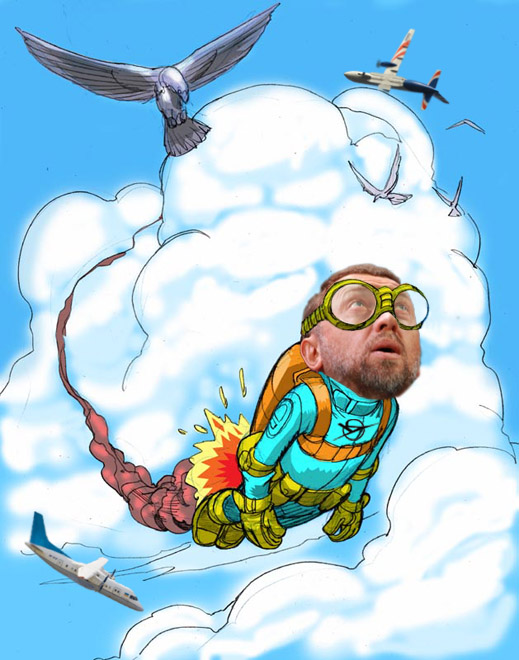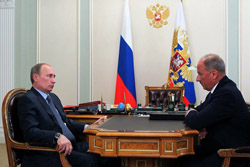
By John Helmer, Moscow
Oleg Deripaska is flying to the rescue of the Fatherland, again.
Russia is now a war economy, even if not all the Kremlin officials in charge will admit it publicly, as they squabble privately over what to do, and who will gain. “A new industrialization for the country”, Deputy Prime Minister in charge of the military-industrial complex, Dmitry Rogozin, announced on Sunday night television – without saying what place the old, unsanctioned oligarchs may have to play, or the new oligarchs on the American proscription list.
Deripaska’s new idea is an old one, the Patriot Plane. This is an outlay of up to Rb16 billion ($450 million) in fresh state budget money to finance his production of a new short-haul aircraft, the Ilyushin-114. Deripaska’s new bid to fly soldiers and commuters follows years of failure at his Samara aircraft plant, Aviacor, to find customers for the plant’s Soviet-era Tupolev-154 model (below, left); for the Ukrainian-designed Antonov-140 (centre); for the troop and cargo transport, the Antonov-70 (centre right); and for Deripaska’s analogue for the Cessna and Beechcraft flying ambulance (far right).

Early this month, according to Moscow Arbitrazh court records, the Defense Ministry charged Aviacor with defaulting on contracts to deliver 14 An-140 transports. The ministry is claiming recovery of Rb915 million ($25 million) for payments received without corresponding aircraft deliveries.
Aviacor’s financial reports show that as new aircraft orders plummet, losses are mounting. Revenue for the March quarter of this year came to just Rb81.9 million, compared to Rb890.3 million in the same period of 2013. Losses for the first quarter totalled Rb32.4 million. For the year 2013, Aviacor has reported losses of Rb760.6 million on revenues of Rb2.6 billion. About 10% of the workforce was cut between January and April of this year.
In parallel, Deripaska’s other outings in the aerospace sector – Kuban Airlines and Sochi Airport – have ended in bankruptcy and heavy financial losses for the state banks. The tale of the Kuban Airlines collapse can be read here. For the tale of Sochi Airport, click here. And for a full list of Deripaska’s holdings in the sector, click.
 Resistance among the state banks to fresh financing for Deripaska’s schemes was expressed last week by Vnesheconombank (VEB), which is under pressure from the Kremlin to find cash to offset the impact of sanctions on the Russian economy. A source close to Rusal says that VEB’s chief executive Vladimir Dmitriev (right) is emphatic in his request to the government to stop fresh credits for Deripaska until he starts repaying old ones.
Resistance among the state banks to fresh financing for Deripaska’s schemes was expressed last week by Vnesheconombank (VEB), which is under pressure from the Kremlin to find cash to offset the impact of sanctions on the Russian economy. A source close to Rusal says that VEB’s chief executive Vladimir Dmitriev (right) is emphatic in his request to the government to stop fresh credits for Deripaska until he starts repaying old ones.
How determined President Vladimir Putin is to override the opposition to Deripaska among his advisors and the government ministries is unclear. On July 21 Putin visited the Samara region, and presided at a discussion of investment plans for Samara’s aerospace sector. Putin inspected a rocket engine plant, and looked at a rival for one of Aviacor’s light aircraft designs, a short-haul turboprop called the Rysachok (“Little Trotter”).

Putin also accepted a pitch from Aviacor, and ordered the government to evaluate the options for commencing production of the IL-114, replacing the links to the Ukraine for the An-140, on which Aviacor has been dependent. Putin’s direction implied that he favours Deripaska for the new aircraft production line.
 Opposition to this registered swiftly. Late in August the ministries of defence and industry combined to tell the press they were backing Deripaska’s rivals. The press leaks attacked Aviacor’s technical readiness, its financial capability, the additional costs, and Deripaska’s creditworthiness. For Aviacor to build the IL-114, announced deputy industry minister Yury Slusar (right, top) there are insufficient orders from the military. “The profitability is highly questionable,” he told Izvestia. Deputy Prime Minister Rogozin (right, bottom), claimed the industry press, was against Aviacor, and is backing the plants of the state-owned United Aircraft Corporation (UAC) instead.
Opposition to this registered swiftly. Late in August the ministries of defence and industry combined to tell the press they were backing Deripaska’s rivals. The press leaks attacked Aviacor’s technical readiness, its financial capability, the additional costs, and Deripaska’s creditworthiness. For Aviacor to build the IL-114, announced deputy industry minister Yury Slusar (right, top) there are insufficient orders from the military. “The profitability is highly questionable,” he told Izvestia. Deputy Prime Minister Rogozin (right, bottom), claimed the industry press, was against Aviacor, and is backing the plants of the state-owned United Aircraft Corporation (UAC) instead.
At a meeting of the contenders in Moscow on September 9, Rogozin sounded a warning against Deripaska. “Aviacor is a private corporation,” he was reported as saying, “and you need to invest public money. On what terms to do this?” Rogozin suggested that if state budget funds are to be spent on the IL-114 project, Deripaska should give up his shareholding in Aviacor to the state, along with management control.
Reports from the meeting suggest that Rogozin also declared himself in favour of Ilyushin Aviation Complex, a unit of state-owned UAC, based in Moscow.
Another rival for Deripaska and Aviacor is also favoured by Rogozin, in part because it is state owned and the expenditure of cash can be supervised more closely than Deripaska is trusted to do. This is the Voronezh Aircraft Manufacturing Company (VASO), based in Voronezh and owned by UAC, with a small shareholding by Ilyushin.
In an analysis this month of the aircraft options, Russian aviation expert Vladimir Karnozov warned that IL-114 is a boondoggle. Why, he asked, if the IL-114 aircraft wasn’t a priority a year ago, should it become one now? Karnozov estimates that with investment in new production capacities at Aviacor of up to Rb12 billion, and another Rb4 billion required for redesign of the older models on the drawing board, the new scheme of IL-114 may be costlier than is warranted by its low military priority, and the availability of alternative transports for military and civilian applications. After reviewing performance records for older-model IL-114s, its engines and other components, Karnozov concluded the avionics are “outdated…engine life is worthless, the MOT program prehistoric.”
“We must understand that we have to talk, not just about the digitization of drawings and installation of more reliable engines. What is required is a fundamental modernization of all systems, recalculation of the airframe with the use of modern materials, and most importantly, the organization of production from the ground up on entirely new principles… This plane will always be small-scale and high cost. And if you aim at building a modern, reliable and affordable production aircraft, the costs and time required to start the production of IL-114 will be comparable to the creation of a similar aircraft from scratch. So the question arises: should we get hung up on the IL-114, when with the same effort you can create a whole new plane?”
For further analysis in English by Karnozov, with technical comparison of the IL-114 with Canadian and Italian analogues, see.
Like Rogozin, Karnozov favours Ilyushin, Sukhoi and VASO for the project, not Aviacor. He also concedes that the IL-114 project is less a military, or even an industrial project, and much more a social scheme to protect jobs. But that too is under attack from the nationalists who have begun organizing behind Colonel Igor Strelkov (Girkin), the commander of the Donetsk forces until he was replaced by the Kremlin in August. Strelkov has publicly accused Deripaska of providing engines for the Ukrainian tanks used against the Donetsk and Lugansk forces. For the time being, Strelkov, who has vocally attacked the loyalties of Russian oligarchs during the course of the Ukraine conflict, has attacked only one of them by name — Deripaska.
 This sharpens the political sensitivity of the IL-114 project, and the outcome Rogozin will argue for Putin to decide. Industry executives like Sergei Yurasov, chief executive of VASO (right, with Dmitry Medvedev in 2010), has publicly acknowledged that Deripaska’s Aviacor is a rival for state financing. But he won’t discuss what he expects to happen next.
This sharpens the political sensitivity of the IL-114 project, and the outcome Rogozin will argue for Putin to decide. Industry executives like Sergei Yurasov, chief executive of VASO (right, with Dmitry Medvedev in 2010), has publicly acknowledged that Deripaska’s Aviacor is a rival for state financing. But he won’t discuss what he expects to happen next.
Rogozin was asked to clarify his preference for the state-owned plants over Deripaska’s Aviacor. Nikita Anisimov, Rogozin’s spokesman, promised a reply, but this hasn’t materialized.











Leave a Reply